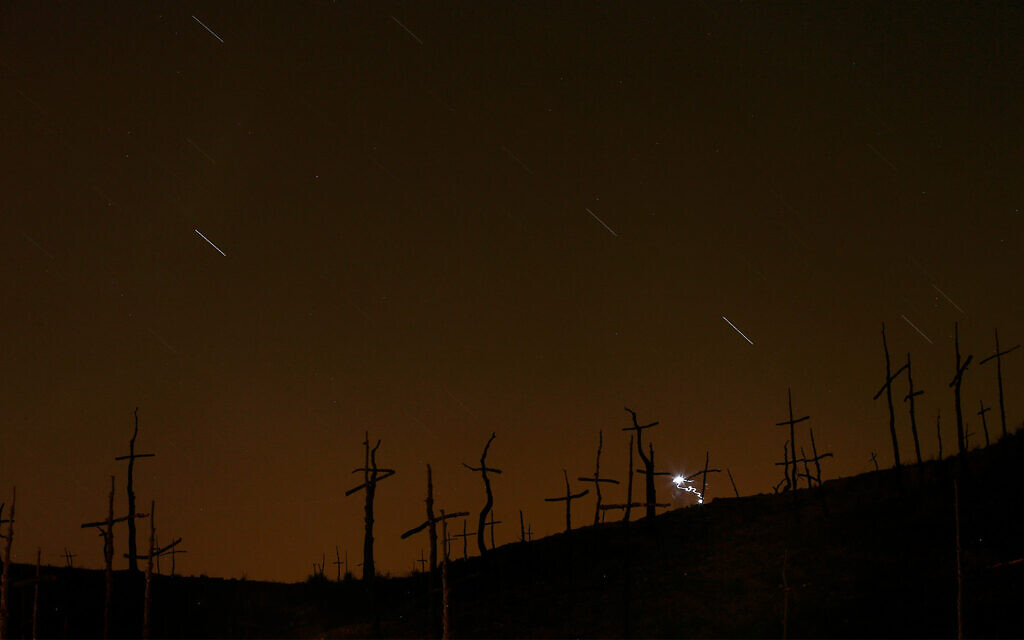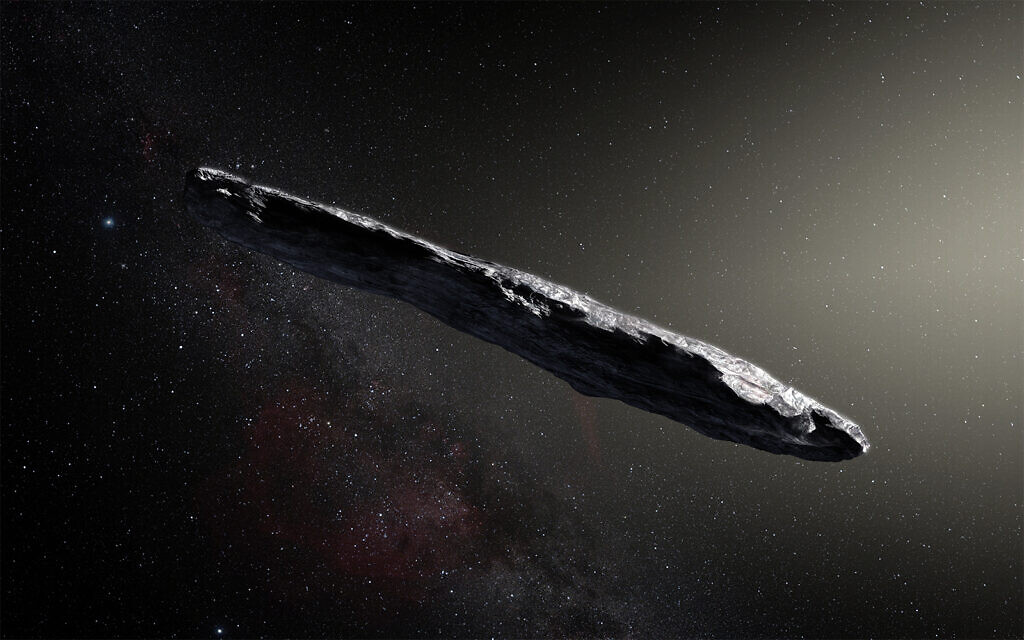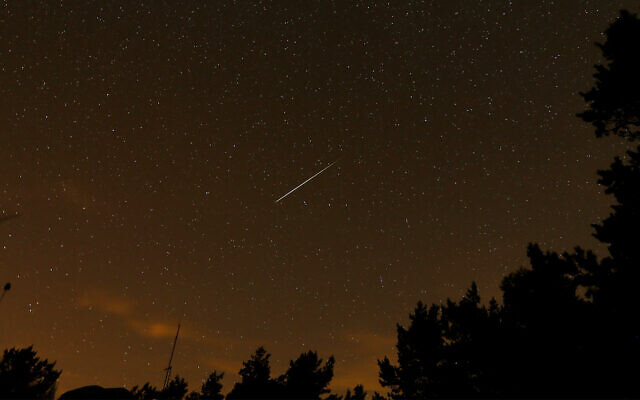US Space Command confirms study by Avi Loeb and Amir Siraj, who picked up on 2014 space rock that hit near Papua New Guinea, but were initially dismissed
By LUKE TRESS 17 April 2022
(AP Photo/Francisco Seco)
An Israeli astronomer and his research partner identified the first interstellar meteor known to have hit the Earth, the US military has confirmed.
The space rock crashed into our atmosphere off the coast of Papua New Guinea in 2014, and is the third object known to have visited our solar system from outside of the sun’s orbit.
Avi Loeb, a Harvard astronomer from Israel, and his research partner Amir Siraj determined that it came from outside our solar system in 2019, but were unable to confirm the finding until this month.
Loeb is a well-known and controversial astronomer who argues that another interstellar visitor, an object called Oumuamua that hurtled past the sun in 2017, could have been made by an alien civilization.
Scientists have also identified a comet that came into our neighborhood from another solar system, making the 2014 meteor the third known interstellar object, and the first to strike the Earth. Meteors are relatively small celestial objects made of rock and metal that enter the Earth’s atmosphere.
Loeb and Siraj were met with skepticism when they announced the finding, until the US military confirmed their results.
The US Space Command, part of the US Department of Defense, said its deputy commander, John E. Shaw, and chief scientist, Joel Mozer, confirmed that the “previously-detected interstellar object was indeed an interstellar object.”
The data “confirmed that the velocity estimate reported to NASA is sufficiently accurate to indicate an interstellar trajectory.”
The Space Command scientists analyzed additional data to confirm Loeb and Siraj’s finding, and presented the results to NASA and the European Space Agency. Space Command is responsible for US military operations in space and monitors space objects that could threaten the Earth.
NASA disputed the Space Command confirmation of the meteor, saying, “the short duration of collected data, less than five seconds, makes it difficult to definitively determine if the object’s origin was indeed interstellar.”
The meteor, known as CNEOS 2014-01-08, was about the size of a dishwashing machine and streaked into our atmosphere near Papua New Guinea’s Manus Island on January 8, 2014.
Siraj wrote in Scientific American this week that US government satellites designed to detect missile launches collected data on the meteor.
Siraj was an undergraduate at Harvard at the time of the discovery, with Loeb acting as his adviser. The two were studying Oumuamua when they began looking for other interstellar objects, and soon came across the data on the meteor.
An Israeli astronomer and his research partner identified the first interstellar meteor known to have hit the Earth, the US military has confirmed.
The space rock crashed into our atmosphere off the coast of Papua New Guinea in 2014, and is the third object known to have visited our solar system from outside of the sun’s orbit.
Avi Loeb, a Harvard astronomer from Israel, and his research partner Amir Siraj determined that it came from outside our solar system in 2019, but were unable to confirm the finding until this month.
Loeb is a well-known and controversial astronomer who argues that another interstellar visitor, an object called Oumuamua that hurtled past the sun in 2017, could have been made by an alien civilization.
Scientists have also identified a comet that came into our neighborhood from another solar system, making the 2014 meteor the third known interstellar object, and the first to strike the Earth. Meteors are relatively small celestial objects made of rock and metal that enter the Earth’s atmosphere.
Loeb and Siraj were met with skepticism when they announced the finding, until the US military confirmed their results.
The US Space Command, part of the US Department of Defense, said its deputy commander, John E. Shaw, and chief scientist, Joel Mozer, confirmed that the “previously-detected interstellar object was indeed an interstellar object.”
The data “confirmed that the velocity estimate reported to NASA is sufficiently accurate to indicate an interstellar trajectory.”
The Space Command scientists analyzed additional data to confirm Loeb and Siraj’s finding, and presented the results to NASA and the European Space Agency. Space Command is responsible for US military operations in space and monitors space objects that could threaten the Earth.
The meteor, known as CNEOS 2014-01-08, was about the size of a dishwashing machine and streaked into our atmosphere near Papua New Guinea’s Manus Island on January 8, 2014.
Siraj wrote in Scientific American this week that US government satellites designed to detect missile launches collected data on the meteor.
Siraj was an undergraduate at Harvard at the time of the discovery, with Loeb acting as his adviser. The two were studying Oumuamua when they began looking for other interstellar objects, and soon came across the data on the meteor.

The Perseid meteor shower, seen in Marganell, Spain, on August 12, 2016. (AP Photo/Manu Fernandez)
Siraj said dozens of similar meteors strike Earth each year, but this one was traveling exceptionally fast and coming from an unusual direction, indicating it came from outside of our solar system.
The meteor was traveling in an “unbound orbit,” while other meteors travel in closed orbits as they circle around the sun. Before hitting Earth, the meter had been traveling at a speed of around 60 kilometers (37 miles) per second, far faster than other meteors.
Loeb and Siraj drafted a paper on their discovery and submitted it for peer-reviewed publication, but journals refused the research, citing its reliance on confidential information. Some of the US government data is kept secret for security reasons. The pair said at the time they were 99.999% confident in their conclusions.

Israeli Harvard scientist Avi Loeb. (Screenshot/YouTube)
They were later approached by a defense official who was able to get official Defense Department confirmation of the find.
The meteor is the third interstellar object ever sighted in our solar system, after Oumuamua and a comet sighted in 2019 called Birosov, neither of which hit the Earth. Comets are smaller objects made out of ice, dust and rocky particles; asteroids are much larger bodies made of rock and metal.
Siraj said his and Loeb’s findings on the interstellar meteor imply that there are many more such objects. He said its speed suggests it could have come from “deep within another planetary system,” close to that system’s star, as opposed to the edge of another system, which was seen as more likely.
The researchers are looking into whether it’s possible to retrieve fragments of the meteor from the bottom of the Pacific Ocean, calling a physical sample “the holy grail of interstellar object studies.” The meteor broke up as it entered our atmosphere.
Loeb was the longest-serving chair of Harvard’s Department of Astronomy, a position he held from 2011-2020, and is currently a tenured science professor at the university.
Related: Israeli Harvard astronomer has an inalienable gravitation to interstellar study
He came to public prominence after asserting that Oumuamua, an anomalous object from outside the solar system observed tumbling past the sun in 2017, could have been an extraterrestrial artifact.
Astronomers in Hawaii only glimpsed the object they called Oumuamua, meaning “scout” in Hawaiian, as it careened away from the sun, moving irregularly. The strangely shaped body was the first known interstellar object seen in our solar system. It appeared to be small, under 1 kilometer in length, dark red and shaped like either a cigar or a pancake.

An artist’s impression of the interstellar asteroid Oumuamua. Scientist Avi Loeb believes it could have been an extraterrestrial artifact. (Courtesy/European Southern Observatory, M. Kornmesser)
Loeb argued Oumuamua could have been an extraterrestrial artifact, such as a light sail powered by solar rays, or a communication dish. Most astronomers believe it was natural in origin, but differ in opinion on what it was, or where it came from.
He launched the Galileo Project last year, an initiative that will systematically search for physical artifacts produced by “extraterrestrial technological civilizations.” Previous programs, such as the SETI Institute, scoured the cosmos in search of electromagnetic signals, not objects.
The Galileo Project aims to identify unidentified aerial phenomena and “Oumuamua-like interstellar objects” through scientific analysis of data collected with cutting-edge instruments. The data and analytical process will be transparent and open to the public, the group said.
Siraj is now the director of interstellar object studies for the Galileo Project, and said this week that the group has received funding to research a possible “spacecraft rendezvous” with an interstellar object to extract a physical sample.
Loeb is from the moshav of Beit Hanan in central Israel, served in the Israel Defense Forces’ prestigious Talpiot program and received his first degree from the Hebrew University in Jerusalem.

No comments:
Post a Comment